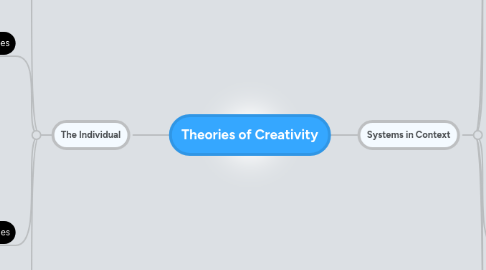
1. The Individual
1.1. Psychoanalytic Theories
1.1.1. Freud
1.1.1.1. tied creativity to drives deriving from the id (primitive unconscious drives)
1.1.1.2. suppression of desires and urges leads to internal defense mechanisms - healthy, productive sublimation
1.1.2. Kris and Kubie
1.1.2.1. basic process of creativity is regression in service of the ego
1.1.2.2. two phases
1.1.2.2.1. inspirational phase deriving from uncontrolled unconscious
1.1.2.2.2. elaborational phase directed by the conscious ego
1.1.2.3. roots in the preconscious (state between sleep and wakefulness or during daydreams)
1.1.3. Jung
1.1.3.1. patterns in human behavior, story, and myth that transcend time or culture may be explained by a human collective unconscious
1.1.3.2. inborn possibilities of ideas
1.1.3.3. explains the similarities of earth-mother figures, creation myths, and resurrection and flood stories found in widely separated cultures
1.2. Contemporary Psychoanalytic Theories
1.2.1. Rothenberg
1.2.1.1. Janusian Process - opposites are conceived simultaneously
1.2.1.2. homospatial process - conceiving of two or more entities occupying the same space at the same time
1.2.2. Miller
1.2.2.1. the roots of creativity are in repressed childhood trauma
1.3. Behaviorist Theories
1.3.1. Skinner
1.3.1.1. there can be no truly original behaviors or ideas, except as they are an inevitable product of unique individual's experiences
1.3.1.2. Glover and Gary - behaviors, including creativity, can be manipulated and reinforced with rewards
1.3.2. Mednick
1.3.2.1. creative ideas result from a particular type of response, the bringing together of remote, unrelated ideas
1.3.2.1.1. importance of knowledge base
1.3.2.1.2. those able to make multiple associations with a given idea are more likely to make unusual association
1.3.2.1.3. the greater the number of diverse associations, the greater the probability that remote ideas may be connected
1.4. Humanist Theories
1.4.1. Maslow
1.4.1.1. special talent creativity - independent of goodness or health of character and we know very little about it
1.4.1.2. self-actualizing creativity - manifestation of mental health and movement toward self-actualization
1.4.2. Rogers
1.4.2.1. creativity as the product of healthy human growth
1.4.2.2. emergence of novel products through the interaction of an individual and the environment
1.4.2.3. necessary characteristics for creativity to take place:
1.4.2.3.1. creative individuals are free of psychological defenses that would keep them from experiencing their environment (openness to experience)
1.4.2.3.2. internal locus of evaluation - reliance on one's own judgement in gauging creative products
1.4.2.3.3. ability to toy with elements and concepts
2. Systems in Context
2.1. Csikszentmihalyi
2.1.1. creativity as an interaction among person, product, and environment
2.1.1.1. domain-specific knowledge base
2.1.1.2. field (social structure of a domain)
2.1.1.3. influence of those in the field on individual
2.1.2. variations may result from cognitive flexibility
2.2. Gardner
2.2.1. individuals create in particular, domain-specific ways
2.2.2. individuals may be creative in more than one domain
2.2.3. five types of creative activities
2.2.3.1. solving a particular problem
2.2.3.2. putting forth a general conceptual scheme
2.2.3.3. creating a product
2.2.3.4. giving a stylized performance
2.2.3.5. performing for high stakes
2.3. Feldman
2.3.1. seven dimensions that may influence creative processes
2.3.1.1. cognitive processes
2.3.1.2. social and emotional processes
2.3.1.3. family aspects (growing up and current)
2.3.1.4. education and preparation (formal and informal)
2.3.1.5. characteristics of domain and field
2.3.1.6. sociocultural contextual aspects
2.3.1.7. historical forces, events, and trends
2.3.2. creativity occurs within specific domains and there is no general trait of creativity
2.4. Sternberg and Lubart & Sternberg and O'Hara
2.4.1. investment in ideas - creative individuals pursue ideas that are novel or out of favor and convince the field of the value of those ideas
2.4.2. individuals who pursue already popular trends or solutions are less likely to achieve valuable original results
2.4.3. important characteristics
2.4.3.1. selective encoding (sifting relevant from irrelevant information)
2.4.3.2. problem definition
2.4.3.3. strategic use of divergent thinking
2.4.3.4. selective combination
2.4.3.5. selective comparison of information
2.4.4. eight creative categories
2.4.4.1. replication
2.4.4.2. redefinition
2.4.4.3. forward incrementation
2.4.4.4. advance forward incrementation
2.4.4.5. redirection
2.4.4.6. reconstruction
2.4.4.7. reinitiation
2.4.4.8. integration
2.5. Gruber
2.5.1. creative people develop along such idiosyncratic paths that generalizations are likely to be minimally useful
2.5.2. case studies more useful to understand the depth of distinctive processes of highly creative individuals
2.6. Simonton
2.6.1. creative ideas are produced through random combinations of mental elements
2.6.2. the greater and more varied the number of combinations, the greater the likelihood of a creative idea
2.6.3. "survival of the fittest" - the best ideas will surface to the conscious mind for fuller consideration
2.6.4. confluence of logic, chance, genius, and zeitgeist (context)
2.7. Amabile
2.7.1. circumstances conducive to creativity
2.7.2. three domains
2.7.2.1. domain-relevant skills
2.7.2.2. creativity-relevant skills
2.7.2.3. task motivation

